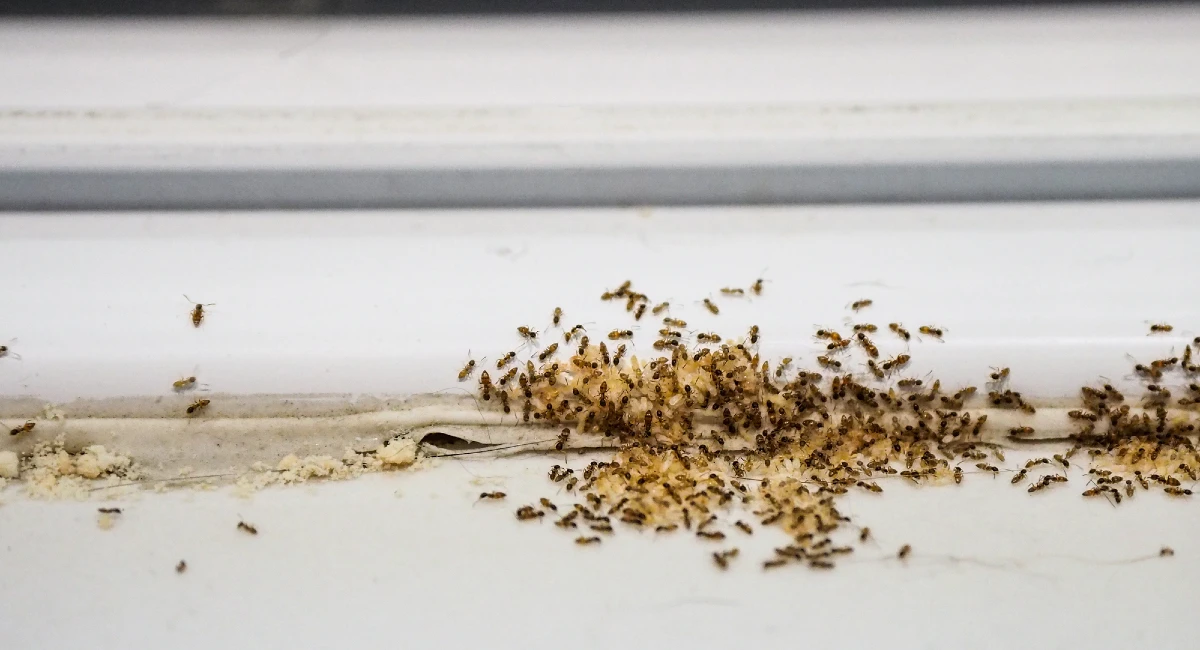
How to Prevent Ant Infestations at Home
Table of Contents
ToggleTable of Contents
- Maintain Cleanliness
- Store Food Properly
- Seal Entry Points
- Eliminate Moisture Sources
- Use Natural Repellents
- Landscape Maintenance
- Regular Inspections
- When to Seek Professional Help
Introduction
Ants are persistent household pests that often invade kitchens, pantries, and even living spaces as they seek out food and water. These tiny creatures are incredibly resourceful and can infiltrate even the cleanest of households with surprising ease. Instead of reacting to a full-blown invasion, it’s much easier and more effective to stop ants before they establish a colony. By understanding how ants gain access and what attracts them, you can implement targeted prevention strategies that keep your home ant-free all year round. It only takes a small lapse in cleanliness for ants to establish a trail, so consistency is key. If ant problems persist despite your best efforts, don’t hesitate to consider professional ant extermination services for more comprehensive protection, as experts can identify root causes and provide lasting solutions.
Below, you’ll discover practical steps to safeguard your home from ants so that you can enjoy a clean and pest-free environment throughout the year. Preventive action not only protects your home’s hygiene but can also reduce the stress and frustration of sudden infestations. With a combination of daily habits, attention to detail, and a proactive mindset, you can dramatically reduce the risk of ant problems.
Maintain Cleanliness
Maintaining a clean home is crucial in discouraging ants from setting up shop inside. These small pests are drawn to even the tiniest crumbs and sticky spots that humans often overlook. A single sweet spill near a sink or an unnoticed cookie crumb under a table leg can become the starting point for an ant trail. Ants rely heavily on scent trails to locate food, so failing to clean thoroughly can encourage them to return and invite others to follow. Investing extra effort will save you from headaches later on. Consider establishing a daily routine of sweeping and wiping high-traffic areas, and pay close attention to eating zones and children’s play areas. Consistency here really makes a difference.
- Wipe Surfaces: Clean kitchen counters, tables, and floors daily with a disinfectant or soap and water, ensuring you get into corners and crevices where food debris might accumulate. Giving special attention to greasy areas—such as near the stove—will further reduce attractants. Don’t forget to clean up immediately after cooking and eating to remove any residue that ants could smell.
- Wash Dishes Promptly: Leaving dirty dishes in the sink, even for a brief period, is enough to attract ants. Get into the habit of washing up immediately after meals and snacks. Dishes with sugary or oily residue are particularly enticing, so keeping your sink empty is essential. If you use a dishwasher, rinse items before leaving them inside to be washed later.
- Take Out Trash Regularly: Ants are drawn to food waste in garbage cans. Always use bins with tight-fitting lids and empty them frequently, especially if you dispose of food scraps in them. Cleaning out the bin itself with soapy water every week prevents buildup of sticky residues—and the odors that attract ants in the first place.
Store Food Properly
Storing your food securely can make a significant difference in how attractive your home is to ants. During warmer months, ants tend to be even more active in their search for nourishment. Open bags, loosely closed boxes, and fruit left out on counters are open invitations for invasion. Take the time to inspect your pantry for potential hazards and establish effective storage practices for all staples.
- Use Airtight Containers: Store dry foods, such as rice, flour, sugar, cereal, and snacks, in airtight containers rather than open bags or boxes. This prevents access to ants and preserves food freshness. Investing in glass or plastic containers with secure seals helps eliminate odors and prevent easy access for pests. Regularly check cabinets and shelves for spills and wipe them up as needed.
- Manage Pet Food: Chow for pets can often be an ant magnet. Use sealed containers for pet food, avoid leaving uneaten pet food out, and clean the feeding area daily. If your pet grazes throughout the day, consider feeding smaller amounts more frequently so there is less opportunity for ants to discover a steady food supply.
Seal Entry Points
Ants can squeeze through extremely small openings to gain entry. They are masters at finding weak points in your home’s defenses, such as cracks, gaps, and imperfect seals. Identifying and sealing these access spots is an effective pest prevention measure that can yield fast results. Inspections should be methodical—don’t forget to check seldom-inspected areas, such as under sinks, behind large appliances, or around utility penetrations.
- Inspect and Seal Cracks: Regularly examine windowsills, doorframes, baseboards, and exterior foundations for tiny cracks, holes, or gaps. Use caulk or weather stripping to seal these vulnerabilities. Pay particular attention to areas where pipes, cables, or vents enter your home, as these places are routinely overlooked. Applying expanding foam or silicone caulk blocks pathways before ants can take advantage of them.
- Install Door Sweeps: Gaps under doors provide easy entry for ants. Install door sweeps or thresholds at all exterior doors to block their path. For sliding doors, behavioral habits (such as always closing the door after use) work in conjunction with weather stripping to prevent ants from gaining easy access.
Eliminate Moisture Sources
Aside from food, ants also seek out water, especially during dry spells. Damp areas serve as both drinking sources and suitable nesting locations for certain ant species. Some types of ants, such as carpenter ants, are even attracted to areas where wood has been softened by moisture, which can lead to structural damage over time. Vigilance about moisture control is an often-overlooked aspect of pest prevention.
- Fix Leaks: Repair any dripping faucets, leaking pipes, or faulty appliances quickly. Even minor leaks beneath sinks or behind toilets can create welcoming conditions for ants. Frequently check bathrooms, laundry rooms, and basements—not just kitchens—for excess moisture or condensation, as ants may go unseen until the problem is larger.
- Ensure Proper Drainage: Make sure that gutters are clean, downspouts direct water away from the foundation, and no stagnant water is collecting around or under your house. Landscaping should slope away from the foundation, and flower pots or lawn ornaments that trap rainwater should be emptied to avoid creating hidden reservoirs for ants and other pests.
Use Natural Repellents
Several natural substances can effectively deter ants—without exposing your family or pets to harsh chemicals. Trying these options can provide you with additional layers of defense, especially in sensitive areas like kitchens, nurseries, or pet spaces, where minimal chemical use is a priority. Natural repellents can also be used reactively (when you spot ants) or as a preventive measure.
- Vinegar Solution: Create a spray from equal parts white vinegar and water. Spraying this solution on countertops, baseboards, entry-prone areas, and visible ant trails disrupts the scent trail ants use to navigate. Vinegar doesn’t just mask the ants’ chemical signals—it breaks them down, making it much harder for ants to maintain their established routes.
- Essential Oils: Certain essential oils, such as peppermint, tea tree, and lemon, possess strong scents that repel ants. Mix a few drops of the solution in water and spray it at the door or window frames, or where you’ve spotted ants entering. You can also place cotton balls soaked in essential oil in cabinets or under appliances for lasting protection.
Landscape Maintenance
Your home’s exterior environment impacts the likelihood of an ant invasion indoors. Landscaping that encourages moisture or provides nesting opportunities significantly increases your risk of damage. Ant colonies often establish themselves near homes, venturing inside when conditions are favorable. Mindful yard care is just as critical as indoor housekeeping in your anti-ant strategy.
- Trim Vegetation: Ants often use tree branches, shrubs, or climbing vines as “bridges” to get into your home. Trim back all vegetation so it doesn’t touch exterior walls or the roofline. It limits their access points and reduces moist hideouts where they may build nests.
- Remove Debris: Clear stacks of firewood, piles of leaves, or excess mulch near your foundation, as these items provide prime nesting sites for ant colonies. Store firewood at least a few feet from your home, keep mulch away from the foundation, and clear away grass clippings or other debris regularly.
Regular Inspections
Ongoing vigilance is vital to catching ant problems before they escalate. Ants can be extremely discreet until their presence becomes obvious, so regular self-inspections are essential. Making these checks part of your monthly home maintenance routine can spare you from sudden, larger-scale invasions.
- Monitor for Trails: Look for visible ant trails, which are often a sign of a nearby nest. Wipe out and clean these trails, and note recurring routes that may indicate entry points. Don’t ignore even one or two stray ants—where there’s one, a colony may follow.
- Check Hidden Spaces: Regularly examine hidden spots—like beneath sinks, behind appliances, inside cabinets, and in your basement or crawl space—for signs of ants or their nests. Look for tiny piles of soil, discarded wings, or frass (ant “sawdust”), which can point to hidden infestations.
When to Seek Professional Help
If you continuously spot ants despite following prevention techniques, it could mean there’s a larger nest nearby, or you’ve encountered a more persistent species. Professional pest control specialists can identify the offending species, locate hidden colonies, and apply targeted treatment strategies to eliminate pests effectively. Their services are especially effective for dealing with repeated or large-scale ant problems and can provide peace of mind for homeowners struggling with ongoing infestations. A pest control expert will also offer recommendations on structural improvements and long-term monitoring tailored to your specific home and region, making it easier to remain ant-free in the future.
With a mix of daily habits, targeted preventive action, and prompt intervention when needed, you’ll be well equipped to keep ants out—and maintain a comfortable, pest-free home environment. Little changes—such as closing food containers tightly, caulking a gap, or quickly drying up spills—can make all the difference. The sooner you act, the easier it is to keep ants at bay and protect your living space.






